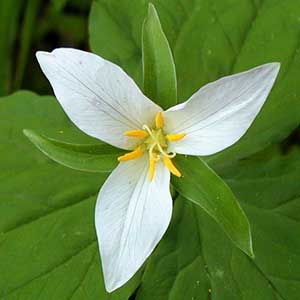Trillium ovatum
Trillium discolor
Pacific trillium, trillium, western trillium, western wake-robin, western white trillium, white or western trillium, white trillium
mottled wakerobin, pale yellow trillium, small yellow toadshade
semierect to horizontal, short, stout, praemorse.
horizontal, brownish, short or somewhat compressed-thickened, bulblike, praemorse, not brittle.
1–2, round, 2–5 dm, ± slender, glabrous.
1–2, 1–2.2 dm, slender, essentially glabrous.
sessile, subsessile, or short-petiolate;
blade medium green, sometimes blotched and mottled, main veins prominent, ovate-rhombic, 7–12 × 5–20 cm, continuing to expand during anthesis, base rounded, apex acuminate.
held well above ground, sessile;
blade mottled dark green over lighter green, mottling fading or blurring with time, ovate, elliptic to almost circular, 6–13 × 4–7 cm, apex acute to acuminate.
erect or nodding, odorless;
sepals spreading to horizontal, green, lanceolate to oblong-lanceolate, 15–50 × 6–20 mm, margins entire, apex acute;
petals erect-ascending, usually wide-spreading from base, exposing entire pistil, white or with pink or blush markings, lacking V-shaped markings, fading to rosy pink, purple, or dark red, veins not deeply engraved, ± linear to widely obovate, 1.5–7 ×1–4 cm, widest at or above middle, thin-textured, margins flat to undulate, apex acuminate;
stamens prominent, slightly recurved-spreading to straight, 10–18 mm;
filaments white, shorter than anthers, slender;
anthers yellow, 4–16 mm, slender, dehiscence latrorse-introrse;
ovary green or white, ovoid, 6-angled, 5–12 mm, attachment ± 3/4 ovary width;
stigmas recurved, barely connate basally, greenish white or white, linear, not lobed adaxially, 6–10 mm, uniformly thin;
pedicel erect to leaning, 2–6 cm.
erect, odor faintly pleasant, resembling sweetshrub (Calycanthus sp.);
sepals displayed above bracts, spreading, green, oblong-lanceolate, shorter than petals, 20–30 × 7–19 mm, margins entire, apex acute;
petals long-lasting, erect, ± connivent, ± concealing stamens and ovary to spreading distally, soft pale sulfur-yellow, fading to ± cream, sometimes slightly spirally twisted, widely spatulate, clawed basally, 2.2–5 × 0.9–1.5 cm, thick-textured, margins entire, often upraised adaxially, at least 1 petal with apex strongly apiculate, nipplelike, others with apex apiculate-acuminate;
claw green, sometimes obscurely marked or mottled with purple, broadly cuneate;
stamens incurved-erect, 8–15 mm;
filaments purple, 1–2.5 mm;
anthers erect, straight or arcuate, brown, 6.5–14 mm, dehiscence introrse-latrorse;
connectives straight, extending 1–2 mm beyond anthers;
ovary purplish, ovoid, 6-ridged, 2.5–8.5 mm;
stigmas divergent to erect, distinct, purplish white, subulate, short, 2–6 mm, ± fleshy.
baccate, green or white, ± odorless, broadly ovoid, obscurely winged, 1.2–2.8 × 0.7–1.9 cm, pulpy-moist.
baccate, greenish white, subglobose, weakly 6-winged, 1–5 × 1 cm, pulpy or mealy, not juicy.
= 10.
= 10.
Trillium ovatum
Trillium discolor
Varieties 2 (2 in the flora).
(Discussion copyrighted by Flora of North America; reprinted with permission.)
Trillium discolor occurs only in the upper drainage of the Savannah River, but it is locally frequent within its limited range.
(Discussion copyrighted by Flora of North America; reprinted with permission.)
1. Bracts sessile; petals lanceolate to obovate, 1.5–7 × 1–4 cm | var. ovatum |
1. Bracts distinctly short-petiolate; petals linear to linear-lanceolate, 0.5–2.4 × 0.2–0.6 cm | var. oettingeri |
- Local floras:
BC,
CA,
OR,
WA
- Local Web sites:
CalFlora,
CalPhotos,
Flora NW,
PNW Herbaria,
Turner Photog.
WildflowerSearch
iNaturalist (observations)
USDA Plants Database
- LBJ Wildflower Center
- SEINet
- Plants of the World Online
- Encyclopedia of Life
- Wikipedia
- Google Image Search


